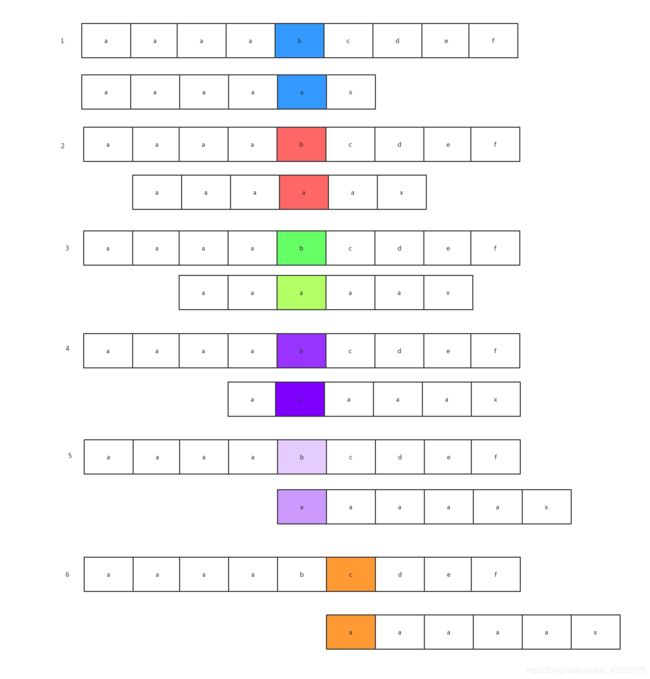模式匹配算法
文章目录
- 串运算的概念浅析
- 串大小的比较:
- Brute-Force算法
- KMP算法
- KMP算法的改进
串运算的概念浅析
模式匹配:子串的定位操作被叫做串的模式匹配。
串大小的比较:
串相等:串长度相等且各个对应位置的字符都相等。 一种最简单粗暴的模式匹配算法,目的是为了寻找模式串T是否在目标串S中有出现。 成功条件:当循环结束时,判断j的值与模式串p的长度是否相等,如果相等,说明匹配成功到了模式p的最后一个字符。 返回值:失败返回0,成功返回模式串在目标串中出现的位置。 因为BF算法的过于低效,所以诞生了KMP算法。 如果目标穿为aaaabcde
当两个串不相等时,判断两个串大小的方法:
给定两个串:S1 = “a1a2a3a4…an”和S2 = “b1b2b3b4…bm”,当满足以下条件之一时,S1
Brute-Force算法
思想:先从主串第i个字符开始匹配,如果T[j]==S[i],那么继续向下比较,一旦不相等,即回溯到目标串的下一个字符即(i = i-j+2),重复工作。int bf(char *mother_string, char *son_string, int position)
{
size_t i = position;
size_t j = 1;
while (i <= strlen(mother_string) && j <= strlen(son_string)) {
if (mother_string[i] == son_string[j]) {
i++;
j++;
} else {
i = i - j + 2;
j = 1;
}
}
if (j == strlen(son_string) + 1) {
return i - strlen(son_string);
} else {
return 0;
}
}
KMP算法
KMP模式匹配算法的原理:#define SIZE_NEXT 225
void get_kmp_next(char *string, int *next)
{
size_t i = 1;
int j = 0;
next[1] = 0;
while (i < strlen(string)) {
if (j == 0 || string[i] == string[j]) {
i++;
j++;
next[i] = j;//更新模式串string每个位置上对应的位置变化
} else {
j = next[j];//回溯j值
}
}
}
// next[j] = x意味着重新开始比的时候,对于模式串string来说前x-1个不用比较,肯定是相同的,只需要从第x个开始即可
int kmp(char *mother_string, char *son_string, int position)
{
size_t i = position, j = 1;
int *next = (int *)malloc(SIZE_NEXT*sizeof(int));
get_kmp_next(son_string, next);
while (i < strlen(mother_string) && j < strlen(son_string)) {
if (j == 0 || mother_string[i] == son_string[j]) {// j == 0意味着第一个字符就不相同 如果j != 0 且不相等那么else更新j的位置。
i++;
j++;
} else {
j = next[j];
}
}
if (j == strlen(son_string) + 1) {
return i-strlen(son_string);
} else {
return 0;
}
}
KMP算法的改进
模式串为aaaaax,那么模式串的next数组值分别为012345
按照上面的KMP算法,我们将会得到以下的过程
 但我们会发现,2,3,4,5步完全是多余的判断,由于模式串的2,3,4,5位置的字符都与1位置的相等,那么我们就可以用1位的next数组值去取代与它相等的字符后续next[j]的值,我们将取代next数组的数组命名为nextval数组。
但我们会发现,2,3,4,5步完全是多余的判断,由于模式串的2,3,4,5位置的字符都与1位置的相等,那么我们就可以用1位的next数组值去取代与它相等的字符后续next[j]的值,我们将取代next数组的数组命名为nextval数组。void get_kmp_nextval(char *string, int *nextval)
{
size_t i = 1;
int j = 0;
nextval[1] = 0;
while (i < strlen(string)) {
if (j == 0 || string[i] == string[j]) {
i++;
j++;
if (string[i] != string[j]) {
nextval[i] = j;
} else {
nextval[i] = nextval[j];
}
} else {
j = nextval[j];
}
}
}